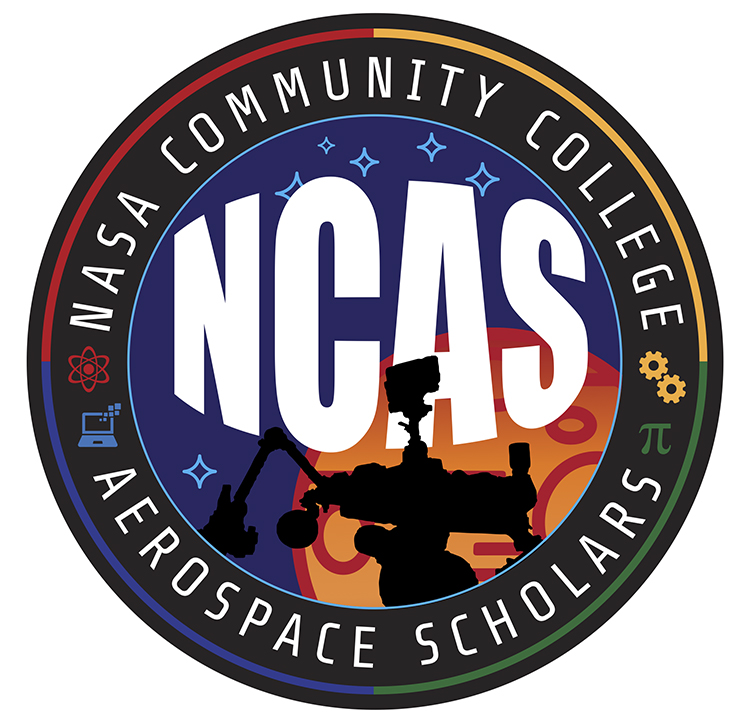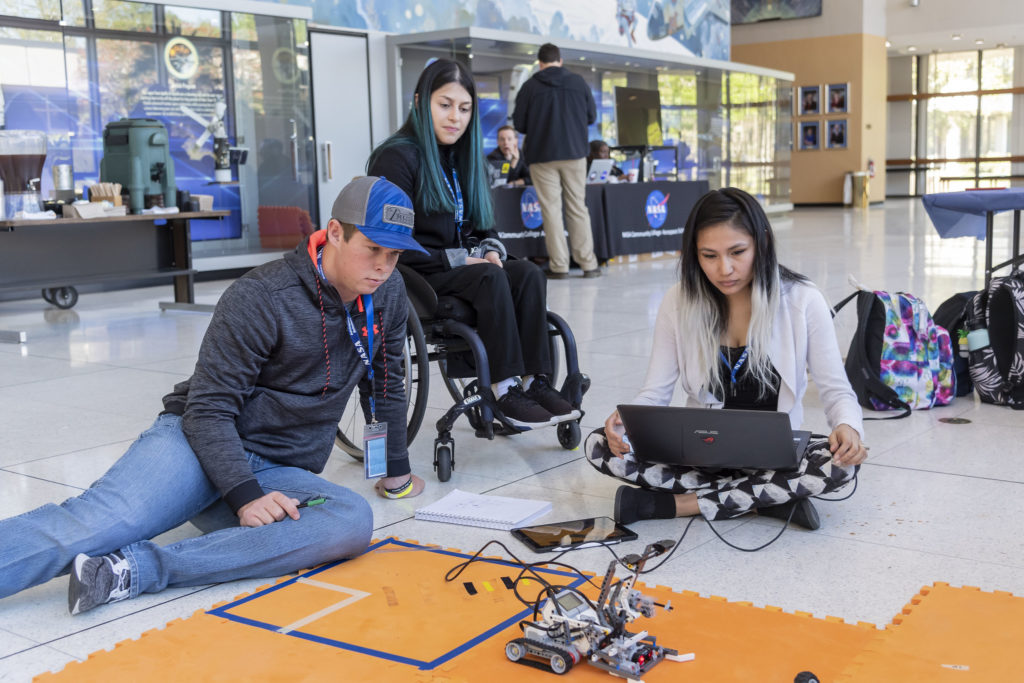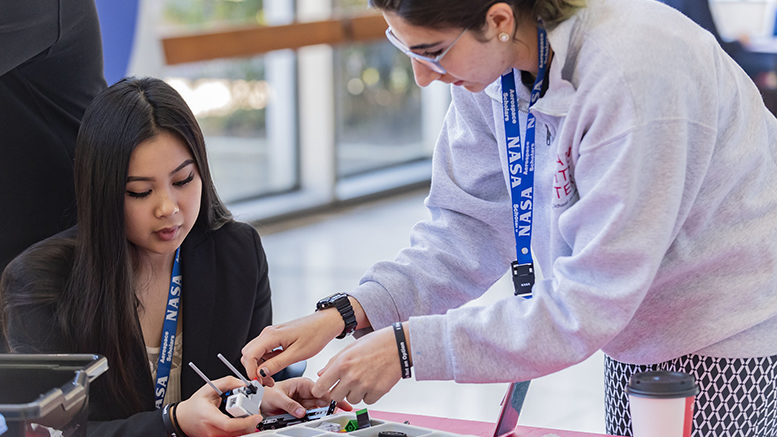While Team Dragon and the NASA SpaceX mission to the International Space Station received global applause in 2020, a less-publicized but important mission began November 18 with the launch of the Mars rover Perseverance. Scheduled to land on the Red Planet on February 18, 2021, it represents efforts by many NASA scientists to explore Mars.
While NASA Community College Aerospace Scholars (NCAS) didn’t work on that mission, the program for two-year college students has encouraged them to pursue STEM careers for 15 years – and provided some of those NCAS participants with practical experience learning how to build and program their own Mars rovers.
With the advent of the coronavirus and global pandemic, teaching methods were adjusted to fit the changing needs of NCAS students, but the substance remains the same: to provide online learning experiences and exciting opportunities to explore science and careers in STEM-related fields.
Then and now: The pandemic present
NCAS is an interactive online learning opportunity for community college students; its highlight is a multiple-day, on-site experience at one of 10 NASA centers. Community college students from across the country are chosen to participate in the program through a competitive process. The project includes preliminary, interactive web-based activities for five weeks. Then selected students are encouraged to study science, technology, engineering and mathematics as they interact with NASA engineers at one of those 10 centers.

Those NCAS online learning activities were not affected by the pandemic. However, this year – and until it’s safe again – the NASA on-site experience is virtual. The NCAS team and representatives from multiple NASA centers collaborated on and created a unique virtual NASA experience replacement.
“Students receive many of the same experiences as the face-to-face NASA experience, including NASA mentors, behind-the-scenes tours and inspirational messages from NASA interns who share similar stories about their lives,” said NASA education specialist Alex Gladney-Lemon. “The health and safety of our NCAS participants is our primary concern. NCAS wants students to return to face-to-face visits but only in a safe and healthy way. The virtual NASA experience will continue as long as conditions warrant.”
The NCAS team created an innovative, “gamified” virtual experience, which members believe will continue to inspire community college students to complete their STEM degrees and then either transfer to four-year institutions or join the STEM workforce.
“NCAS designed the experience to incorporate synchronous and asynchronous learning,” Gladney-Lemon explained. “The team created multiple ways for students to collaborate with each other and NASA staff, including team meetings; subject matter expert presentations with question-and-answer sessions; ‘coffee hours’ with members of NASA’s workforce; and intern panel discussions.”
She added, “Several students commented that they felt the virtual was a better experience because they had an opportunity to interact with NASA employees at multiple centers – not just one.”
In fiscal year (FY) 2019, NCAS invited 892 students to participate in the NASA experience; it dropped to 773 in FY 2020. During FY 2019, NCAS held 22 on-site experiences at NASA centers and one event at the American Indian Higher Education Consortium student conference.
The NCAS network
During its first 15 years, the NCAS program has changed several times. The current version, which involves collaboration among the 10 NASA centers, has been around for about six years and has more than 3,700 alumni nationwide.
Usually, NCAS works directly with students and not the community colleges they attend. However, community colleges that participated in NASA’s Space Grant network this year applied through their state’s consortia to the Space Grant Solicitation Opportunities for NASA’s STEM fiscal year 2020-2024. Affiliates of the Space Grant college network belong to 52 consortia in 50 states, plus the District of Columbia and the Commonwealth of Puerto Rico.
How do those consortia operate?
NSPACE, for example, comprises a consortium of partners led by Oklahoma State University (OSU).
“Its mission is to collaborate with NASA Johnson Space Center, agency mission directorates and NASA headquarters to provide competitive, innovative STEM educational opportunities to K-16 students and educators,” said NASA education specialist Karen Wilson.
NSPACE currently implements 13 NASA STEM engagement activities, including NCAS, and its team comprises OSU employees who are stationed at six NASA centers around the nation.
“NSPACE handles logistics for these activities, which is why the application for NCAS is housed on the OSU website,” explained NASA education specialist Stacey Welch.
Back to Mars land rovers
Working on their Mars land rovers and experiencing NASA firsthand are what two Dallas College students remember most about NCAS. Although they are NCAS alumni from two non-pandemic years, they recommend the project to all interested students.
Stephen Rowe, who graduated from the Dallas College Cedar Valley Campus and then the University of Texas at Arlington, participated in the 2018 project. A member of the Dallas College STEM League, Rowe decided to apply to NCAS because he wanted to challenge himself and thought it would be a great experience.

“I liked meeting new people who had the same passion for knowledge as I did. The group project was a great learning experience, too,” said Rowe, whose on-site visit was at the Johnson Space Center in Houston. “My favorite activity was learning how to program a mini robot to navigate a Mars-like terrain. The activity forces you to think outside of the box while, at the same time, you are problem-solving with your team.”
He added, “If I was to speak with college students regarding this topic, I would probably note that the experience can be life-changing. It can really open new doors for you.”
Garrett Dale agreed. He visited NASA’s Marshall Space Flight Center in Huntsville, Alabama, in 2017, when he was a student at the Dallas College El Centro Campus.
“The sheer amount of new information about NASA’s history, current missions and planned future learned during the online courses was well worth the time invested,” he said. “The payoff, though, was the on-site experience with the VIPs, site tours and the (robotics) competition, all while integrating with a team of students from around the country.”
Dale’s favorite activity, like Rowe’s, was the robotics competition.
“Our biggest headache at the time was having a kit with a broken touch sensor – the critical piece that all teams use,” he recalled. “They gave us a second after we demonstrated that it was defective, only to receive another that wouldn’t work! Our team rolled with it and pioneered using the light sensor instead. That forced us to be innovative and solve the problem.”
Dr. Jason Treadway, director of the Dallas College STEM Institute, summed up the value of the NCAS program this way: “The NCAS program is a truly amazing opportunity for students to gain real-world experience and explore exciting careers in STEM. I would encourage all students who are pursuing a degree in STEM or who have an interest in STEM to apply. Today’s college students will be the scientists and engineers who make exploration to Mars possible.”

